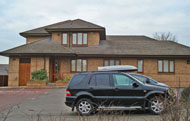Acute
The Hendon (King Edward VII Memorial) Cottage Hospital was opened in 1913 by Princess Henry of Battenberg as a memorial to King Edward VII, who had died in 1910. The Hospital was built on a piece of land in Park Road which had been donated by Lt. Col. Sir Audley Neeld. The building costs of £2200 were paid for by public subscription. It was a pretty hospital with 12 beds and had a state-of-the-art operating theatre.
It was extended in 1925 and again in 1933. By 1936 it had 65 beds, 20 of which were in the new wing for private patients, built during the previous year. At the same time the operating theatre and sterilizing room had been modernised.
In 1936 the average cost of an in-patient was £3 12s 5d (£3.62) per week, compared with 1935, when the cost was £3 6s 1d (£3.30). As now, private patients paid all their costs to the Hospital and medical staff. At this time the charges for a private X-ray were: 3 gns (£3.15) for a chest film, 5 gns for a barium meal (£5.25), 2 gns (£2.10) for a major joint (hip, knee, shoulder) and 1 gn (£1.05) for a smaller joint (wrist, ankle).
In 1948 the Hospital joined the NHS as part of the Hendon Group and was renamed the Hendon District Hospital.It closed in 1987.
Present status (December 2007)
The Hospital was demolished in 1992. The site now contains the Grovemead Health Centre at 67 Elliot Road.

The Grovemead Health Centre as seen from Elliot Road to the north...


... and Park Road to the south
Donations were asked for the following: tin foil (silver paper), aluminium foil and foil from cigarettes packets, chocolates, etc., metal tubes (paint, toothpaste, shaving cream), metal caps, capsules, lead (from tea chests, bullets, buttons, piping) and pewter.
http://rcnarchive.rcn.org.uk (1912)
http://rcnarchive.rcn.org.uk (1913)
www.a2a.org.uk
www.barnet.gov.uk
www.british-history.ac.uk
Return to home page